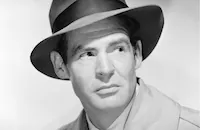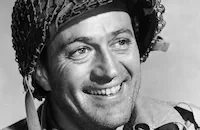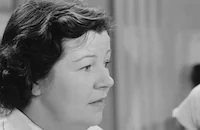Act of Violence

Brief Synopsis
Cast & Crew
Fred Zinnemann
Van Heflin
Robert Ryan
Janet Leigh
Mary Astor
Phyllis Thaxter
Film Details
Technical Specs

Synopsis
At a Memorial Day celebration in the small town of Santa Lisa, California, contractor Frank R. Enley, a World War II Veteran, is honored for bringing a new housing project to the town. On the same day, Joe Parkson, a mysterious and disabled war veteran, arrives in Santa Lisa hoping to find Frank and kill him. Following the ceremony, Frank bids his wife Edith and young daughter Georgie farewell and goes on a fishing trip with his friend, Fred Finney. Only moments after he leaves, Edith receives a telephone call from Joe, who says nothing and hangs up. Joe later visits Edith looking for Frank, and when she tells him the he has gone fishing at the lake, he leaves without explaining himself. At the lake, Joe, carrying a loaded gun, rows out to where Frank is fishing, but is unable to fire a shot at him. When Bobby, the bartender at a shoreline bar, tells Frank that a stranger with a limp was looking for him, Frank immediately realizes who it is and rushes home in a panic. At home, Frank takes every precaution to secure his family's safety, and tells his wife that Joe is an old army pal whom he does not wish to see. Late that night, Frank admits to his wife that he moved the family away from Syracuse, New York, to get away from Joe. He also tells Edith that during the war he and Joe were imprisoned in a Nazi prison camp, and that Joe is mentally ill. One day, when Frank leaves town to go to a builders and contractors convention in Los Angeles, Joe forces his way into the house and tells Edith that her husband is responsible for his disability and the death of some of his army pals. Frightened by the visit, Edith leaves Georgie in the care of her neighbor, Martha, and rushes to Los Angeles. There, Frank admits that he revealed Joe's escape plans to the Nazis to win special treatment for himself. Meanwhile, back in Santa Lisa, Joe learns that Frank is in Los Angeles and decides to search for him there. After checking out of his Santa Lisa hotel room, Joe is surprised by the arrival of Ann Sturges, his girl friend, who has followed him in the hopes of preventing him from killing Frank. When Joe rejects Ann's pleas, Ann finds Edith and warns her about Joe's revenge plans. In Los Angeles, Joe finds Frank at the convention and the two scuffle. Frank manages to escape, and while taking refuge in a bar, meets a prostitute named Pat. Pat takes Frank to Johnny, a killer-for-hire, who uses force and alcohol to persuade Frank to hire him to kill Joe. The following day, Frank returns to Santa Lisa, and, regretting his decision to hire Johnny, tries to warn Joe about the impending attempt on his life. Frank warns Joe only seconds before Johnny fires his gun, and then steps forward to take the bullet himself. Though wounded by the gunshot Frank manages to grab Johnny as he speeds off in his car, causing it to crash into a lamppost. Both Johnny and Frank are killed in the crash, leaving Joe with the responsibility of telling Edith the tragic news.

Director

Fred Zinnemann
Cast

Van Heflin

Robert Ryan

Janet Leigh

Mary Astor

Phyllis Thaxter

Berry Kroeger

Taylor Holmes
Harry Antrim

Connie Gilchrist

Will Wright
Tom Hanlon
Phil Tead
Eddie Waglin
John Albright
William "bill" Phillips
Dick Simmons
Larry Holt
Leslie Holt
Garry Owen
Dick Elliott
Irene Seidner
Ralph Peters
Douglas Carter
Frank Scannell
Rocco Ianzo
Rex Downing
Mickey Martin
Bill Cartledge

Don Haggerty
Paul Kruger
Jim Drum
George Backus
Wesley Hopper
Nolan Leary
Barbara Billingsley
Harry Tenbrook
Everett Glass
Phil Dunham
Fred Santley
William Bailey
Wilbur Mack

Howard Mitchell
Cameron Grant
Ralph Montgomery
Walter Merrill

Roger Moore
Mahlon Hamilton
Candy Toxton
Florita Romero
George Ovey
Jimmy Kelly
David Newell
Fred Datig Jr.

Margaret Bert
Mary Jo Ellis
Ann Lawrence
Andre Pola
Rudolph Anders
Roland Varno
Robert Skelton
Crew
Jack Dawn
Cedric Gibbons
Henry W. Grace
Sydney Guilaroff
Bronislau Kaper
Conrad A. Nervig
Hans Peters
André Previn
Robert L. Richards
Helen Rose
Blanche Sewell
Douglas Shearer
Marvin Stuart
Robert Surtees
Edwin B. Willis
William H. Wright
Collier Young

Photo Collections
Videos
Movie Clip



Trailer
Hosted Intro
Film Details
Technical Specs

Articles
Act of Violence
One of the first post-war film noirs to examine the effects of World War II on returning soldiers, Act of Violence (1948) is especially significant for tackling another controversial topic for its time - wartime ethics on the battlefield. The director, Fred Zinnemann, was just beginning to emerge as a major director and Act of Violence and his next two films, The Men (1950) and Teresa (1951) were all unique in that they addressed specific problems faced by returning war veterans.
In his autobiography Fred Zinnemann, the director wrote, "Perhaps the most vivid memory of making Act of Violence concerns the many sleepless nights we spent shooting exteriors in the eerie slums of downtown Los Angeles. The theme - the fatal flaw in a good man's character - is best expressed in R.L. Stevenson's remark 'A man's character is his destiny,' or, as one of the players puts it, 'You've done it once, you'll do it again.' Zinnemann also added that "the script offered a great range of possibilities for visual treatment; they were thoroughly explored by Bob Surtees, our cameraman....This was the last movie I directed for MGM, and the first time I felt confident that I knew what I was doing and why I was doing it."
According to author Eddy Muller in Dark City: The Lost World of Film Noir, "Robert Richards's screenplay was adapted from an unpublished story by Collier Young, an ambitious assistant to Columbia studio boss Harry Cohn. Young would soon embark on a career as an independent producer with his bride-to-be, Ida Lupino. The film was originally going to be a small indie production starring popular radio personality Howard Duff (who would, coincidentally, succeed Young as Ida Lupino's husband). Then Mark Hellinger picked it up, with the notion of pairing Gregory Peck with Humphrey Bogart." In the end, the project ended up at MGM with Van Heflin and Robert Ryan in the leads.
While Heflin and Ryan are excellent in their roles, Act of Violence is especially interesting for its female supporting cast - Janet Leigh, who was at the beginning of her career, and Mary Astor, who was near the end of hers. In her autobiography, A Life on Film, Astor recalled filming her scenes for Act of Violence while simultaneously shooting Little Women: "For two weeks or so I was with the Zinnemann company playing a sleazy, aging whore, with Van Heflin and Robert Ryan. It was such a contrast that it was stimulating - and reviving....I worked out the way this poor alley cat should look, and insisted firmly (with Zinney's help) that the one dress in the picture would not be made at the MGM wardrobe, but be found on a rack at the cheapest department store. We made the hem uneven, put a few cigarette burns and some stains on the front. I wore bracelets that rattled and jangled and stiletto-heeled slippers. I had the heels sanded off at the edges to make walking uncomfortable. I wore a fall, a long unbecoming hairpiece that came to my shoulder. And I put on very dark nail polish and chipped it. I used no foundation makeup, just too much lipstick and too much mascara..." So Astor, in her Act of Violence makeup and wardrobe, walked over to the Little Women set one day to see how things were going. The director, Mervyn LeRoy, didn't know Astor was moonlighting and according to the actress "took a startled look at me, came over to me, shocked, and said, 'What the hell have you got that kind of an outfit on for? What's the matter with you anyway - you look like a two-bit tart!' I was pleased." Astor also noted that "playing some of the scenes with Van Heflin, working with an artist like Zinnemann - after years of literally nothing - was a tonic. The way we worked, talking about it, thinking about it, using, discarding, trying something else. It was good. It was the way it ought to be - always."
Astor's co-star, Janet Leigh, revealed in her biography, There Really Was a Hollywood, that Act of Violence was "my most demanding role to date," adding, "I was fortunate to be in the company of these talents, and I knew it, and I worked like a demon to prove worthy. It was hard; there wasn't one easy scene. The tension began in the beginning and kept mounting to a crescendo, and I constantly had to overcome the liability of actually being too young for the part...If anything ever went wrong during a rehearsal or a shot, I automatically said, "I'm sorry," immediately assuming it was my fault. And it was many times. But not always. The cast and crew initiated an "I'm sorry" kitty. Every time I said it, I had to put a penny in the jar. It contributed three dollars toward the end of the picture party."
Producer: William H. Wright
Director: Fred Zinnemann
Screenplay: Robert L. Richards
Art Direction: Cedric Gibbons, Hans Peters
Cinematography: Robert Surtees
Editing: Conrad A. Nervig
Music: Bronislau Kaper
Cast: Van Heflin (Frank R. Enley), Robert Ryan (Joe Parkson), Janet Leigh (Edith Enley), Phyllis Thaxter (Ann Sturges), Mary Astor (Pat), Berry Kroeger (Johnny), Taylor Holmes (Gavery), Connie Gilchrist (Martha Finney).
BW-83m. Closed captioning.
by Jeff Stafford

Act of Violence
Quotes
Trivia
Notes
Although Conrad A. Nervig is listed onscreen as the film's editor, Hollywood Reporter production charts list Blanche Sewell as the editor. The CBCS and some contemporary reviews incorrectly list Nicholas Joy in the part played by Taylor Holmes. According to a May 1948 Hollywood Reporter news item, some filming took place at Big Bear Lake, CA.

Miscellaneous Notes
Released in United States December 25, 1948
Released in United States Winter January 1, 1949
Released in United States Winter January 1, 1949
Released in United States December 25, 1948















